Mydailynewz.com ads (fake) - Free Guide
Mydailynewz.com ads Removal Guide
What is Mydailynewz.com ads?
Mydailynewz.com shows fake messages to get users to press the “Allow” button

Mydailynewz.com is a bogus website that displays deceptive messages to trick people into subscribing to push notifications. It gives people the impression that if they click the “Allow” button, they will be able to watch some kind of video. In reality, this page does not have any videos to play and content to explore. Users can come across various messages designed to get users to click the button:
Press Allow to verify your age is 18+
Click Allow to watch the video
Download is ready. Click Allow to download your file
Press Allow to verify that you are not a robot
The “Allow” button gives permission for the site to show push notifications. Users start getting spammed with annoying pop-up ads that can appear even when the browser is closed. Because the creators of the page do not care about user privacy or security, they may use rogue advertising networks[1] that place ads leading to dangerous websites.
As a result, people can end up on scam pages that use social engineering techniques[2] to fool them into providing personal information, downloading PUPs (potentially unwanted programs),[3] and malware. Users should take care of the intruder, especially if there are children using the affected machine. Some people report seeing ads promoting adult and gambling sites that could expose little ones to inappropriate content.
| NAME | Mydailynewz.com |
| TYPE | Push notification spam; adware |
| SYMPTOMS | Pop up ads start appearing in the corner of the screen sometimes even when the browser is closed |
| DISTRIBUTION | Shady websites; deceptive ads; freeware installations |
| DANGERS | Links embedded in the pop-ups can lead to dangerous websites where people might get tricked into providing their personal information or downloading PUPs and malware |
| ELIMINATION | To eliminate push notifications go to your browser settings |
| FURTHER STEPS | Use FortectIntego to clear your browsers and fix performance issues |
Distribution techniques
Such pages can rarely be found in the search results. Usually, they lurk in other shady websites that are unregulated. These are often pages that engage in illegal activities, like illegal streaming sites. They are full of deceptive ads, sneaky redirects, fake “Download” and “Play” buttons.
Even though Google promised to get rid of these buttons, they still exist, and users often get tricked by them. They open new tabs with suspicious pages that can contain similar messages we discussed before. It is not hard to imagine someone believing that they will be able to watch the movie or TV show they selected if they just click “Allow.”
Nowadays, there are plenty of streaming services that require only a small monthly subscription fee. People can also watch as much content as they want and do it safely by not risking infecting themselves with PUPs, and malware.
Another way that Mydailynewz.com could have found its way onto your screen is adware. It is a type of program that hides in the machine and performs various tasks in the background. Users that are infected may experience an increased amount of commercial content, pop-up ads, banners, and redirects.
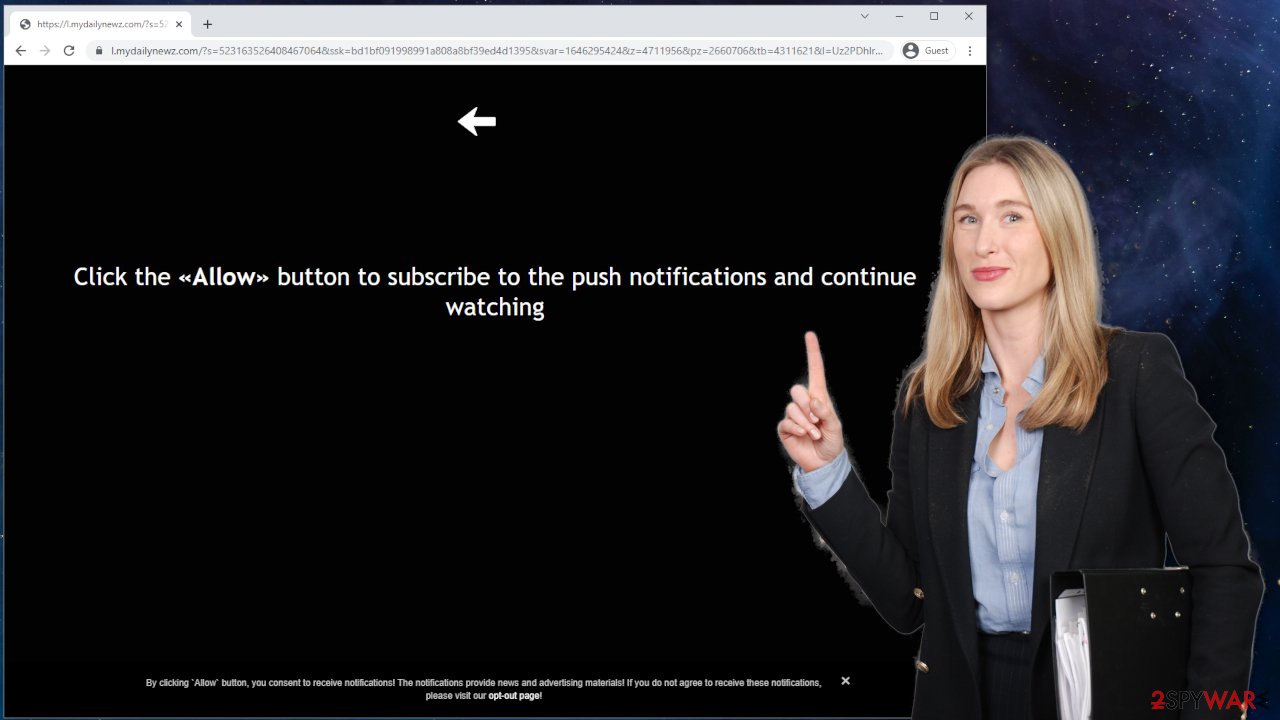
Stop the pop-ups and clear your browsers
If you have had enough of annoying pop-ups, you can remove Mydailynewz.com permissions manually by going to your browser settings. Keep in mind that this might not work if you have an adware infection. If removal from the browser will not work, you will have to access your programs section in the device and find it manually or scan your machine with professional security tools.
After successful removal, you need to take care of your browsers separately. With the help of cookies, shady websites you visited could have collected data about your browsing activities. This includes your IP address, geolocation,[4] links you click on, and things you purchase online. To delete that information, use a maintenance tool like FortectIntego.
Google Chrome (desktop):
- Open Google Chrome browser and go to Menu > Settings.
- Scroll down and click on Advanced.
- Locate the Privacy and security section and pick Site Settings > Notifications.
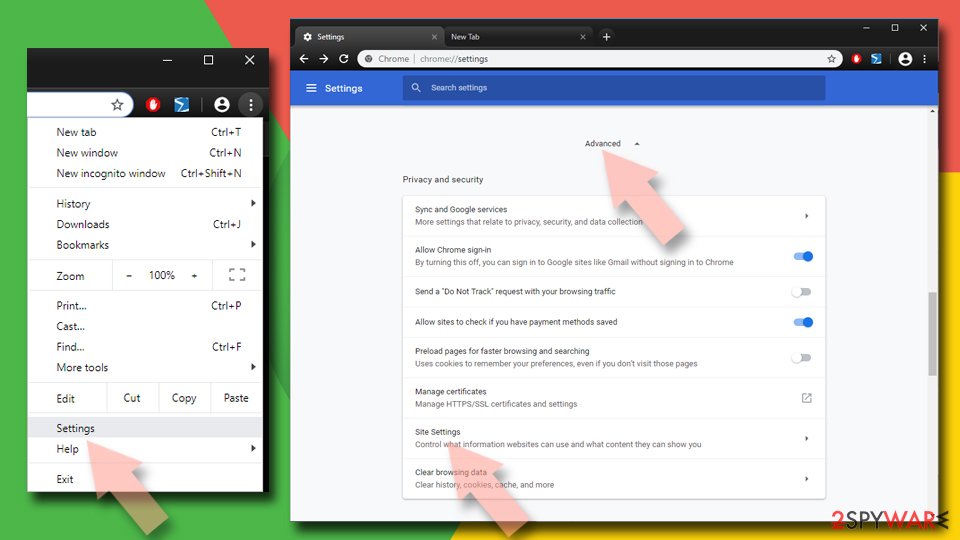
- Look at the Allow section and look for a suspicious URL.
- Click the three vertical dots next to it and pick Block. This should remove unwanted notifications from Google Chrome.
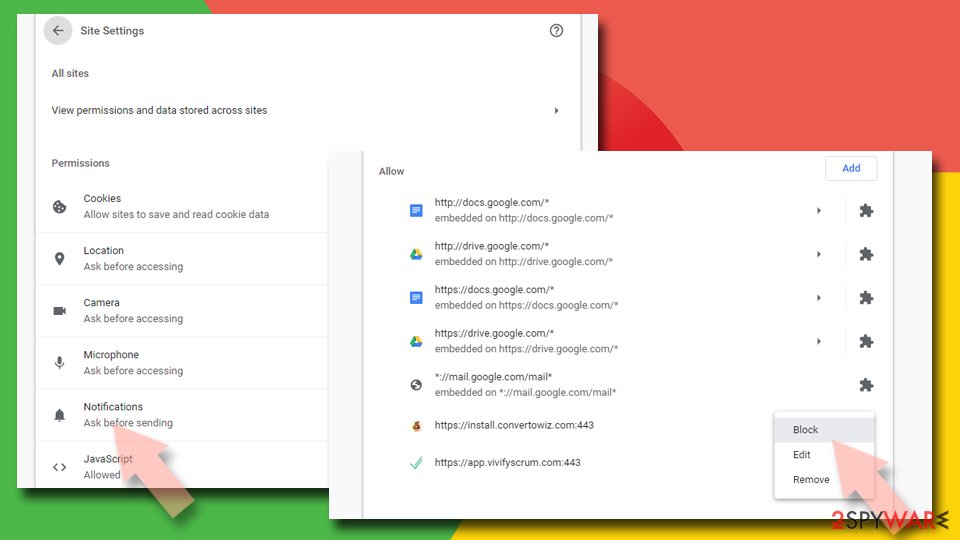
Google Chrome (Android):
- Open Google Chrome and tap on Settings (three vertical dots).
- Select Notifications.
- Scroll down to Sites section.
- Locate the unwanted URL and toggle the button to the left (Off setting).
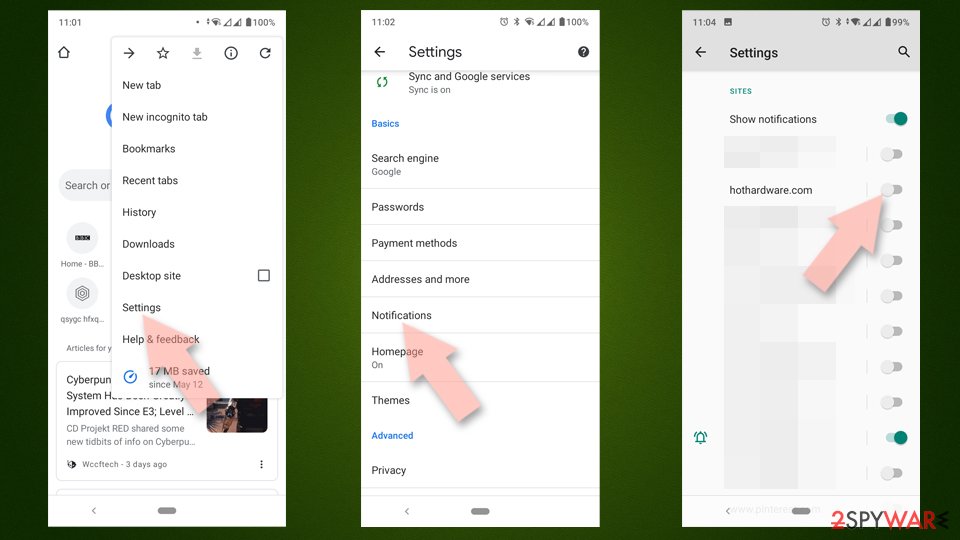
Mozilla Firefox:
- Open Mozilla Firefox and go to Menu > Options.
- Click on Privacy & Security section.
- Under Permissions, you should be able to see Notifications. Click Settings button next to it.
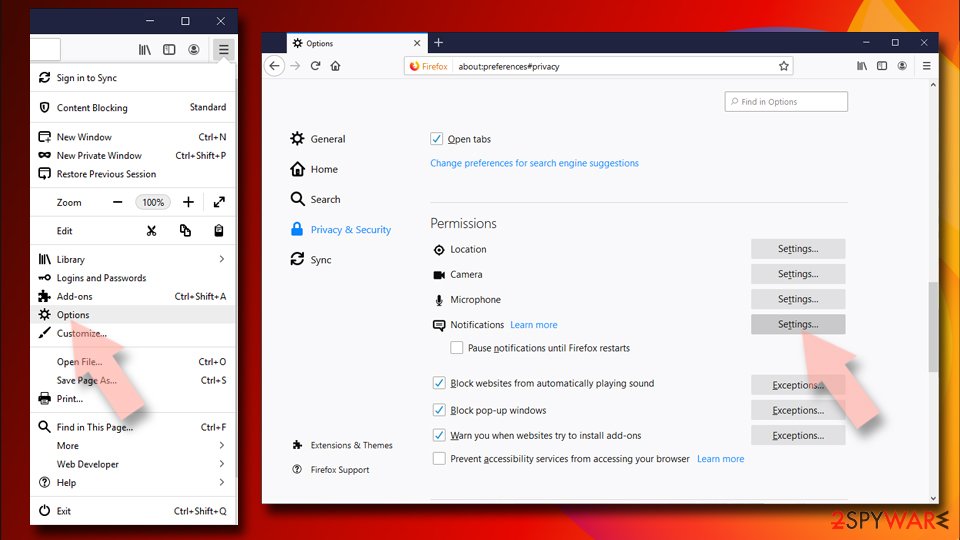
- In the Settings – Notification Permissions window, click on the drop-down menu by the URL in question.
- Select Block and then click on Save Changes. This should remove unwanted notifications from Mozilla Firefox.
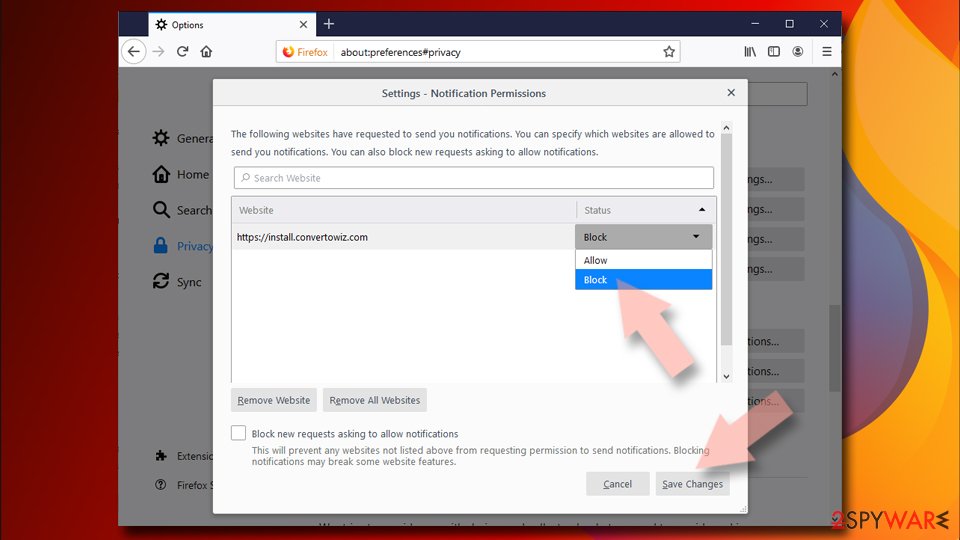
Safari:
- Click on Safari > Preferences…
- Go to Websites tab and, under General, select Notifications.
- Select the web address in question, click the drop-down menu and select Deny.
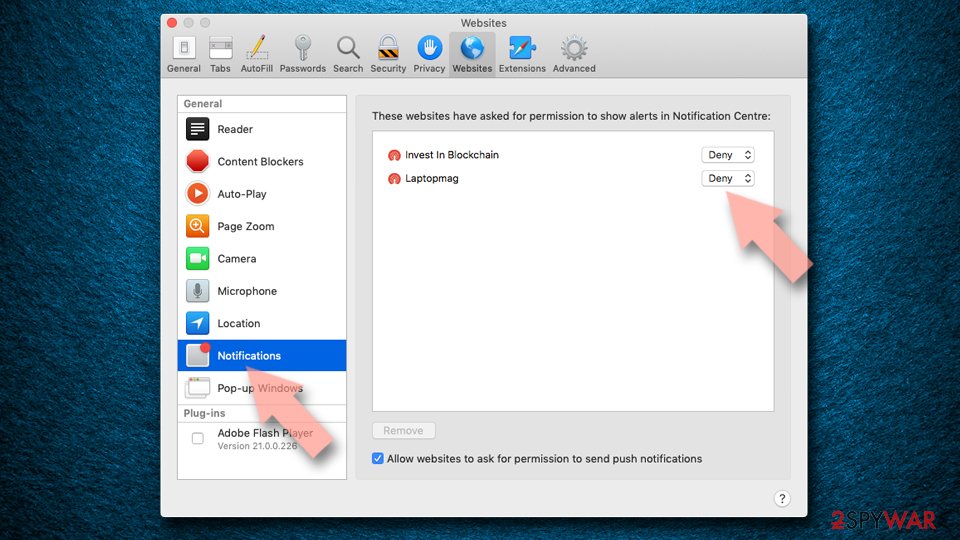
MS Edge:
- Open Microsoft Edge, and click the Settings and more button (three horizontal dots) at the top-right of the window.
- Select Settings and then go to Advanced.
- Under Website permissions, pick Manage permissions and select the URL in question.
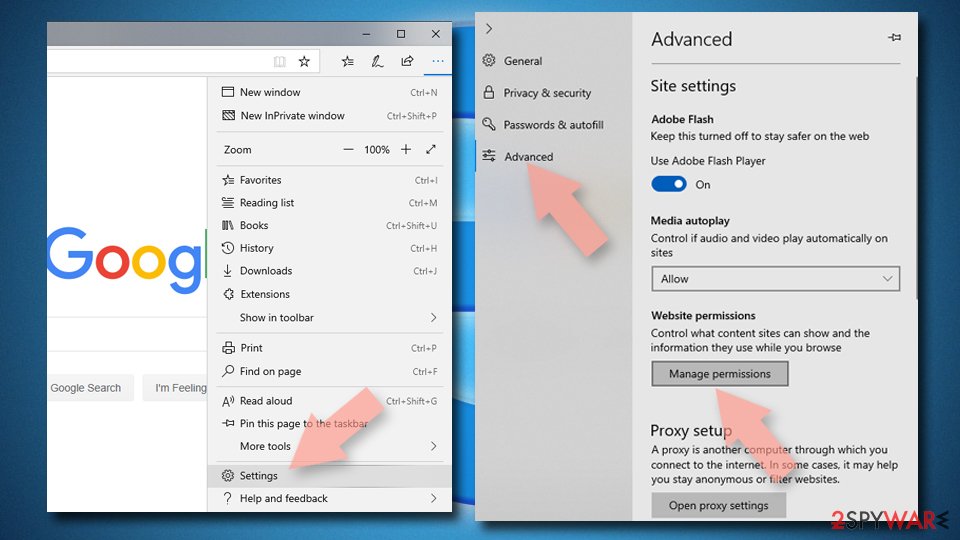
- Toggle the switch to the left to turn notifications off on Microsoft Edge.
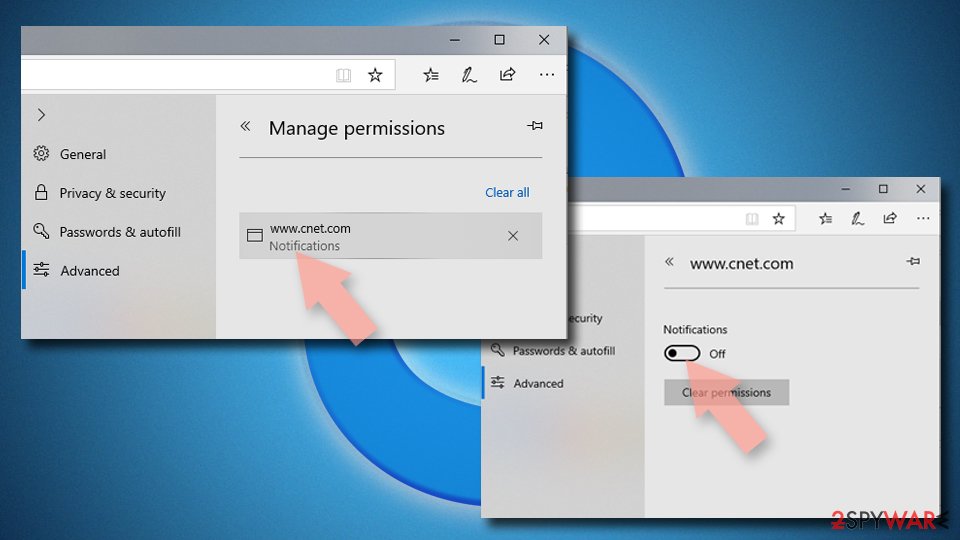
MS Edge (Chromium):
- Open Microsoft Edge, and go to Settings.
- Select Site permissions.
- Go to Notifications on the right.
- Under Allow, you will find the unwanted entry.
- Click on More actions and select Block.
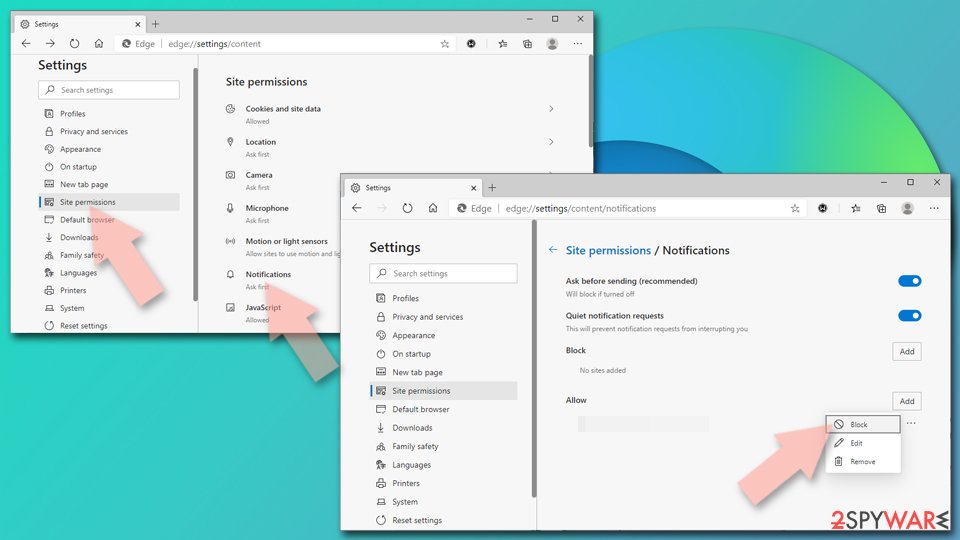
PUPs perform tasks in the background of your machine
If the previous removal method did not work and you still experience symptoms like an increased amount of commercial content, banners, surveys, redirects you might have adware hiding in your system. These programs often infiltrate the systems as bundled software from freeware distribution sites.
To avoid this, users should implement certain steps in their routine. Always choose the “Custom” or “Advanced” installation methods, read the Privacy Policy, and Terms of Use to find out more information about the program. The most important thing is to check the file list and untick the boxes next to any unrelated files.
If you have no idea what app is responsible for such activities, you should deploy SpyHunter 5Combo Cleaner or Malwarebytes professional security software that will perform a full system scan and eliminate it automatically. They can also prevent such infections in the future by warning you. If you still prefer doing it yourself, here are step-by-step instructions for Windows and macOS:
Instructions for Windows 10/8 machines:
- Enter Control Panel into Windows search box and hit Enter or click on the search result.
- Under Programs, select Uninstall a program.

- From the list, find the entry of the suspicious program.
- Right-click on the application and select Uninstall.
- If User Account Control shows up, click Yes.
- Wait till uninstallation process is complete and click OK.

Windows 7/XP:
- Click on Windows Start > Control Panel located on the right pane (if you are Windows XP user, click on Add/Remove Programs).
- In Control Panel, select Programs > Uninstall a program.

- Pick the unwanted application by clicking on it once.
- At the top, click Uninstall/Change.
- In the confirmation prompt, pick Yes.
- Click OK once the removal process is finished.
For macOS users:
- From the menu bar, select Go > Applications.
- In the Applications folder, look for all related entries.
- Click on the app and drag it to Trash (or right-click and pick Move to Trash)

To fully remove an unwanted app, you need to access Application Support, LaunchAgents, and LaunchDaemons folders and delete relevant files:
- Select Go > Go to Folder.
- Enter /Library/Application Support and click Go or press Enter.
- In the Application Support folder, look for any dubious entries and then delete them.
- Now enter /Library/LaunchAgents and /Library/LaunchDaemons folders the same way and terminate all the related .plist files.

How to prevent from getting adware
Choose a proper web browser and improve your safety with a VPN tool
Online spying has got momentum in recent years and people are getting more and more interested in how to protect their privacy online. One of the basic means to add a layer of security – choose the most private and secure web browser. Although web browsers can't grant full privacy protection and security, some of them are much better at sandboxing, HTTPS upgrading, active content blocking, tracking blocking, phishing protection, and similar privacy-oriented features. However, if you want true anonymity, we suggest you employ a powerful Private Internet Access VPN – it can encrypt all the traffic that comes and goes out of your computer, preventing tracking completely.
Lost your files? Use data recovery software
While some files located on any computer are replaceable or useless, others can be extremely valuable. Family photos, work documents, school projects – these are types of files that we don't want to lose. Unfortunately, there are many ways how unexpected data loss can occur: power cuts, Blue Screen of Death errors, hardware failures, crypto-malware attack, or even accidental deletion.
To ensure that all the files remain intact, you should prepare regular data backups. You can choose cloud-based or physical copies you could restore from later in case of a disaster. If your backups were lost as well or you never bothered to prepare any, Data Recovery Pro can be your only hope to retrieve your invaluable files.
- ^ Zeljka Zorz. How does a rogue ad network function?. Helpnetsecurity. Rogueware, Malware.
- ^ Cynthia Gonzalez. Top 5 Social Engineering Techniques and How to Prevent Them. Exabeam. Information Security.
- ^ Wendy Zamora. What is a PUP? – How to avoid potentially unwanted programs. Malwarebytes. Cybersecurity Blog.
- ^ Jake Frankenfield. Geolocation. Investopedia. Financial Technology.
